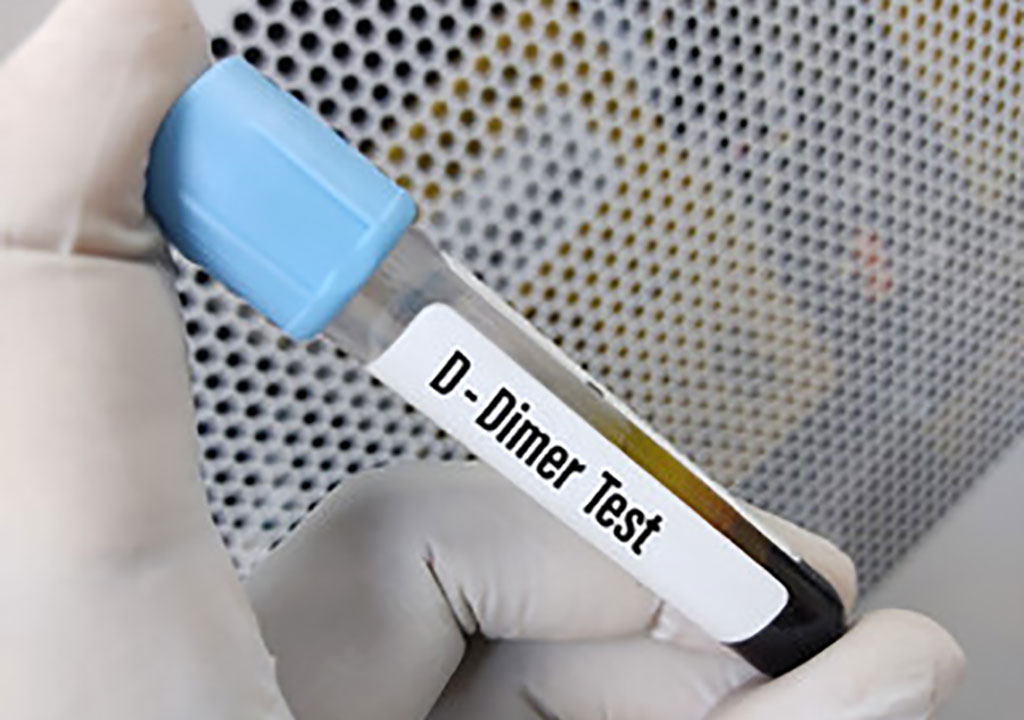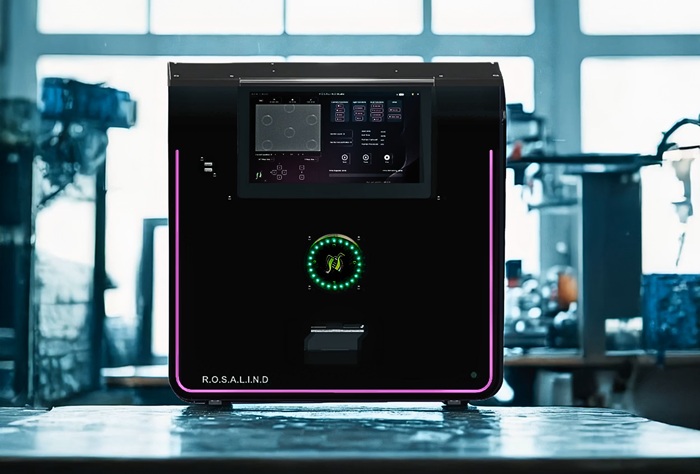D-Dimer Test Can Still Help Rule Out Pulmonary Embolisms in Hospitalized COVID-19 Patients
|
By LabMedica International staff writers Posted on 27 Oct 2021 |

The D-dimer test can still be helpful in ruling out pulmonary embolisms in hospitalized COVID-19 patients, according to a new study.
Researchers at the University of South Florida Health Morsani College of Medicine (USF Health; Tampa, FL, USA) conducted a single-center, diagnostic study to investigate how well D-dimer testing performed at excluding pulmonary embolism in patients hospitalized with COVID-19. They found that the screening blood test originally validated in seriously ill patients without COVID-19 is still clinically useful for ruling out pulmonary embolism in patients hospitalized with the coronavirus.
Pulmonary embolisms occur when blood clots that form in another part of the body (often the leg), travel through the bloodstream, and lodge in the blood vessels of the lung, decreasing blood flow and causing low oxygen levels. Research indicates COVID-19 patients are three to 10 times more likely to develop pulmonary embolisms than other hospitalized patients, even when they are not as seriously ill or immobilized. Scientists are still investigating why, but it appears the COVID-19 virus may create a cellular environment that promotes clotting by making the inside of blood vessels uneven, irritated, and prone to microtears.
Doctors who suspect pulmonary embolisms routinely rely on widely available D-dimer screening to rule out the potentially life-threatening blood clotting disorder – most commonly in surgical patients immobilized for long periods and patients admitted to intensive care units. D-dimer is a simple blood test that measures protein fragments of blood clots floating in the bloodstream. D-dimer levels, normally undetectable or detectable at very low levels, rise sharply when the body is breaking down the clots. A negative D-dimer test (one that rules out pulmonary embolism) can help patients avoid more expensive, invasive diagnostic tests, like a computed tomography pulmonary angiogram, or CTPA.
The USF Health researchers wondered if the increased risk for blood clotting in COVID-19 patients, and uncertainty of diverse D-dimer values found in earlier smaller studies, reduced the existing screening tool’s ability to correctly rule out pulmonary embolism in COVID patients. The conventional thinking was that D-dimer levels would almost always be high in COVID-19 patients, therefore the test as originally validated (in non-COVID patients) would not be accurate at differentiating COVID patients without clots.
The restrospective study looked at the records of 1,541 patients hospitalized with COVID-19 at Tampa General Hospital from Jan. 1, 2020, to Feb. 5, 2021. They compared plasma D-dimer concentrations with CTPA, the criterion for diagnosing pulmonary embolism, in 287 of those patients. All COVID-19 patients with CTPA evidence of pulmonary embolism had D-dimer levels of 0.05 μg/mL or greater, as did the majority (91.2%) of patients without CTPA evidence of pulmonary embolism. (Concentrations of 0.05 μg/mL and higher are considered positive for pulmonary embolism, while anything below that D-dimer level is negative). The researchers also analyzed whether changing the cutoff levels defining positive or negative D-dimer test results specifically for the COVID patient population might improve the test’s performance.
Within the limitations of this single-center study, setting higher D-dimer thresholds was associated with improved specificity – but at “the cost of an increased false-negative rate that could be associated with an unacceptable patient safety risk,” the study authors wrote. A false-negative result means that the test does not detect a pulmonary embolism when the serious blood clotting problem is very likely present. While clinicians must maintain heightened suspicion for pulmonary embolisms when evaluating symptoms in COVID-19 patients, the overall USF Health study results indicate that the currently available D-dimer test adequately screens for the likelihood of pulmonary embolism in hospitalized COVID patients.
“Our study found that clinicians can feel confident interpreting the D-dimer levels the same in COVID patients as they do in every other patient; we don’t need a special (different) value for COVID patients,” said principal investigator Asa Oxner, MD, associate professor and vice chair of USF Health Internal Medicine. “So, in hospitalized COVID patients, we can appropriately rule out a pulmonary embolism if d-dimer levels are low.”
“The mechanisms of developing pulmonary embolisms may differ for COVID patients, but the resulting physiology is the same for all patients. The little fragments of (undissolved) blood clots are still detectable with D-dimer,” said Oxner.
Related Links:
USF Health
Latest COVID-19 News
- New Immunosensor Paves Way to Rapid POC Testing for COVID-19 and Emerging Infectious Diseases
- Long COVID Etiologies Found in Acute Infection Blood Samples
- Novel Device Detects COVID-19 Antibodies in Five Minutes
- CRISPR-Powered COVID-19 Test Detects SARS-CoV-2 in 30 Minutes Using Gene Scissors
- Gut Microbiome Dysbiosis Linked to COVID-19
- Novel SARS CoV-2 Rapid Antigen Test Validated for Diagnostic Accuracy
- New COVID + Flu + R.S.V. Test to Help Prepare for `Tripledemic`
- AI Takes Guesswork Out Of Lateral Flow Testing
- Fastest Ever SARS-CoV-2 Antigen Test Designed for Non-Invasive COVID-19 Testing in Any Setting
- Rapid Antigen Tests Detect Omicron, Delta SARS-CoV-2 Variants
- Health Care Professionals Showed Increased Interest in POC Technologies During Pandemic, Finds Study
- Set Up Reserve Lab Capacity Now for Faster Response to Next Pandemic, Say Researchers
- Blood Test Performed During Initial Infection Predicts Long COVID Risk
- Low-Cost COVID-19 Testing Platform Combines Sensitivity of PCR and Speed of Antigen Tests
- Finger-Prick Blood Test Identifies Immunity to COVID-19
- Quick Test Kit Determines Immunity Against COVID-19 and Its Variants
Channels
Clinical Chemistry
view channel
Noninvasive Blood-Glucose Monitoring Method to Replace Finger Pricks for Diabetics
People with diabetes often need to measure their blood glucose multiple times a day, most commonly through finger-prick blood tests or implanted sensors. These methods can be painful, inconvenient, and... Read more
POC Breath Diagnostic System to Detect Pneumonia-Causing Pathogens
Pseudomonas aeruginosa is a major cause of hospital-acquired and ventilator-associated pneumonia, particularly in lung transplant recipients and patients with structural lung disease. Its ability to form... Read moreMolecular Diagnostics
view channel
Rapid Diagnostic Breakthrough Simultaneously Detects Resistance and Virulence in Klebsiella Pneumoniae
Antibiotic resistance is a steadily escalating threat to global healthcare, making common infections harder to treat and increasing the risk of severe complications. One of the most concerning pathogens... Read more
DNA Detection Platform Enables Real-Time Molecular Detection
A next-gen DNA detection platform enables real-time molecular detection by detecting nucleic acids directly without enzymes or thermocyclers, thereby slashing costs, reducing complexity, and boosting reliability... Read moreHematology
view channel
MRD Tests Could Predict Survival in Leukemia Patients
Acute myeloid leukemia is an aggressive blood cancer that disrupts normal blood cell production and often relapses even after intensive treatment. Clinicians currently lack early, reliable markers to predict... Read more
Platelet Activity Blood Test in Middle Age Could Identify Early Alzheimer’s Risk
Early detection of Alzheimer’s disease remains one of the biggest unmet needs in neurology, particularly because the biological changes underlying the disorder begin decades before memory symptoms appear.... Read more
Microvesicles Measurement Could Detect Vascular Injury in Sickle Cell Disease Patients
Assessing disease severity in sickle cell disease (SCD) remains challenging, especially when trying to predict hemolysis, vascular injury, and risk of complications such as vaso-occlusive crises.... Read more
ADLM’s New Coagulation Testing Guidance to Improve Care for Patients on Blood Thinners
Direct oral anticoagulants (DOACs) are one of the most common types of blood thinners. Patients take them to prevent a host of complications that could arise from blood clotting, including stroke, deep... Read moreImmunology
view channel
Blood Test Could Identify Colon Cancer Patients to Benefit from NSAIDs
Colon cancer remains a major cause of cancer-related illness, with many patients facing relapse even after surgery and chemotherapy. Up to 40% of people with stage III disease experience recurrence, highlighting... Read moreBlood Test Could Detect Adverse Immunotherapy Effects
Immune checkpoint inhibitors have transformed cancer treatment, but they can also trigger serious immune-related adverse events that damage healthy organs and may become life-threatening if not detected early.... Read moreMicrobiology
view channel
Breakthroughs in Microbial Analysis to Enhance Disease Prediction
Microorganisms shape human health, ecosystems, and the planet’s climate, yet identifying them and understanding how they are related remains a major scientific challenge. Even with modern DNA sequencing,... Read more
Blood-Based Diagnostic Method Could Identify Pediatric LRTIs
Lower-respiratory tract infections (LRTIs) are a leading cause of illness and death worldwide, and pneumonia is the leading infectious cause of death in children under five, claiming the lives of over... Read morePathology
view channel
AI Tool Simultaneously Identifies Genetic Mutations and Disease Type
Interpreting genetic test results remains a major challenge in modern medicine, particularly for rare and complex diseases. While existing tools can indicate whether a genetic mutation is harmful, they... Read more
Rapid Low-Cost Tests Can Prevent Child Deaths from Contaminated Medicinal Syrups
Medicinal syrups contaminated with toxic chemicals have caused the deaths of hundreds of children worldwide, exposing a critical gap in how these products are tested before reaching patients.... Read more
Tumor Signals in Saliva and Blood Enable Non-Invasive Monitoring of Head and Neck Cancer
Head and neck cancers are among the most aggressive malignancies worldwide, with nearly 900,000 new cases diagnosed each year. Monitoring these cancers for recurrence or relapse typically relies on tissue... Read moreTechnology
view channel
Machine Learning Models Diagnose ALS Earlier Through Blood Biomarkers
Amyotrophic lateral sclerosis (ALS) is a rapidly progressive neurodegenerative disease that is notoriously difficult to diagnose in its early stages. Early symptoms often overlap with other neurological... Read more
Artificial Intelligence Model Could Accelerate Rare Disease Diagnosis
Identifying which genetic variants actually cause disease remains one of the biggest challenges in genomic medicine. Each person carries tens of thousands of DNA changes, yet only a few meaningfully alter... Read moreIndustry
view channel
BD and Penn Institute Collaborate to Advance Immunotherapy through Flow Cytometry
BD (Becton, Dickinson and Company, Franklin Lakes, NJ, USA) has entered into a strategic collaboration with the Institute for Immunology and Immune Health (I3H, Philadelphia, PA, USA) at the University... Read more








 Analyzer.jpg)















